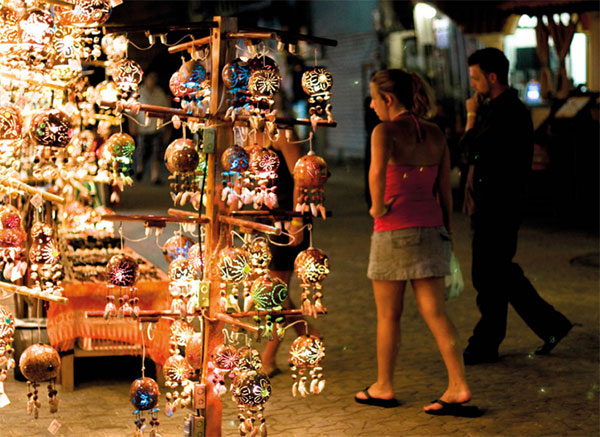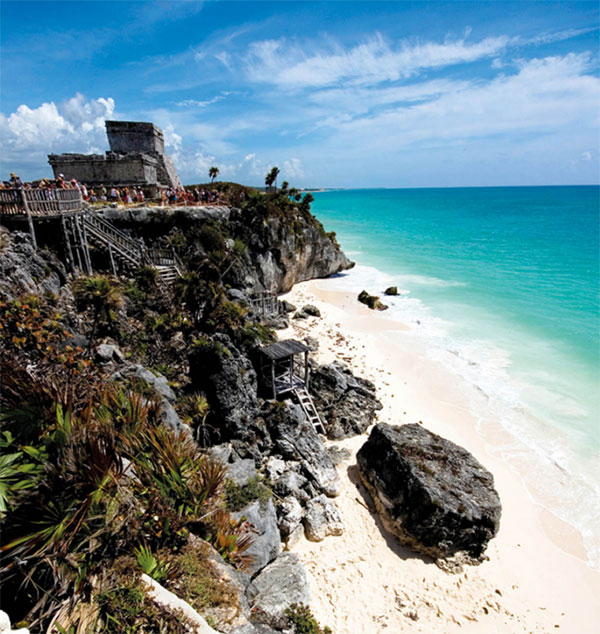Puerto Aventuras to Xel-Há
Puerto Aventuras, 20km (12 miles) from Playa del Carmen, is a purpose-built, Mediterranean-style resort village of hotels and villas created around a lavish marina and another beautiful beach. Just beyond is the series of seven bays known as Xpu-Ha, which are among the Riviera coast’s greatest beauties.

Souvenir shopping in tourist mecca, Playa del Carmen.
Alex Havret/Apa Publications
On the inland side of the highway near Xpu-Ha there are several cenotes (natural sinkholes) that are open to visitors for snorkeling and swimming. Cenote Kantun–Chi (daily 9am–5pm) is a low-key ‘ecopark’ with four gorgeous cenotes, a forest walk, and a little zoo.
The clear waters of the Yal-Ku lagoon (where the Spanish ship Matancero sank in 1741) flow into the sea at the northern end of the resort town of Akumal ! [map] , set around some of the most beautiful bays on the coast, above all the arching Media Luna (‘Half Moon’) bay on the north side. While mostly as new as Puerto Aventuras, Akumal also has a real village at its center, and has a more relaxed feel, with hotels, villas, and condos spread along the long beaches. Akumal is Maya for ‘place of the turtles,’ and the beaches here and at Xcacel just to the south are among the region’s most important turtle-breeding beaches, where from around May to August, green, hawksbill, and loggerhead turtles crawl up onto the sands to lay their eggs. The Centro Ecológico Akumal (www.ceakumal.org), a conservation and research center that organizes ‘turtle watch’ trips at night in the summer season, and is a good source of information.
Easy snorkeling is the biggest attraction at Xel-Há @ [map] (www.xelha.com; daily 8.30am–6pm), just beyond Akumal, where freshwater underground rivers mingle with the ocean in a natural lagoon at the center of an ecological park run by the same organization as Xcaret. An expensive daily admission ticket includes snorkel rental, and swimming with dolphins and bicycle rides through the surrounding forest.
The southern Riviera is the most important area in the world for cave diving, with the cenote entrances to several spectacular cavern systems such as the celebrated Dos Ojos, 2km (1.5 miles) south of Xel-Há, which stretches for at least 61km (38 miles) under the ground – though it may well be longer.
Tulum
Some 27km (17 miles) south of Akumal is the clifftop site of Tulum £ [map] . Originally called Zama, which means ‘dawn,’ due to its location facing the sunrise, Tulum was the largest of the communities that grew up along the coastal trade route in the post-classic era, between about 1300 and the Spanish Conquest.
Tulum is estimated to have had a population of only about 600 at the time of conquest. The priestly and noble classes perhaps resided within the stone walls that still flank the 6.5-hectare (16-acre) core of the site on three sides, with the rest of the population outside. A supreme lord or Halach Uinich headed a council of the leading families, which collected taxes, raised armies, and negotiated alliances with neighboring communities.

Snorkelers enjoy the tropical weather and waters at Xcaret.
Shutterstock
Tulum’s fortress, if this is what it was, sits on dramatic limestone cliffs above powdery white beaches, giving it the most spectacular location of any Maya ruin. The perimeter wall has five entrances and the remains of what may have been watchtowers. The Temple of the Frescos, a two-story structure with columns on the bottom level and a much smaller room on top, has a fresco of human figures in a style that suggests central Mexican influence, and masks of the rain god Chac around the corners of the facade. To the left of the platform in front of El Castillo is the Temple of the Diving God, which has a relief of this strange personage – thought, logically, to be related to fishing – in a relatively good state of preservation over the door. The carvings above doorways are protected with palapa (thatched) canopies.
Tulum’s most imposing building is naturally El Castillo (The Castle), fronted by serpent columns, which was built on top of two earlier pyramids, and probably served as a watchtower and lighthouse as well as a temple. When Grijalva’s Spanish expedition first saw it in 1518, they recorded that a flame was kept burning here day and night. Sadly – as is now the case with most structures at Tulum – you can no longer climb up the Castillo to enjoy the view, but must admire it from behind wire cordons.

Ruins overlooking the beach at Tulum.
Alex Havret/Apa Publications
Tulum Beach and Sian Ka’an
Tulum is also one of the finest of all the Riviera’s beaches, stretching 11km (7 miles) from the ruins down to the entrance gate to the Sian Ka’an preserve. Tulum beach was once the laid-back, bohemian destination on the Riviera, the foremost home of the palm-roofed beach cabaña or hut. However, since its beauty has been recognized by a much broader range of people, the area has gone jetset, with bikini boot camps, yoga studios, and eco-chic hotels that are pushing the backpackers out. Nevertheless, it is still possible to find wonderfully mellow spots along the beach for some thorough relaxation. Some local ‘traditions’ are maintained, such as that Tulum beach has no permanent electricity, but most hotels now have solar power or their own generators functioning for at least part of the day.